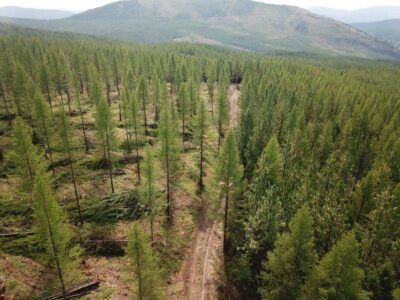California Environmental Blueprint: Environmental monitoring & modeling
This post is the second in our ongoing series on our Environmental Blueprint for California. In our Blueprint, we recommended that Governor Brown establish an independent, statewide agency or council devoted to compilation, modeling, prediction and presentation of environmental quality data. I want to elaborate on what this agency might look like and why we believe such an agency is important to California’s environmental future.
To briefly summarize our Blueprint, we recognize that environmental data collection and modeling requires specialized knowledge and resources, but that much of that knowledge can be generalized across environmental problems and agency jurisdiction. Take mercury contamination, for example, which involves air pollution, surface water pollution, atmospheric deposition and potential groundwater contamination. An environmental monitoring and modeling agency could assess agency progress throughout California independently of regulatory policy and enforcement, facilitate ecosystem-based assessment, and make more efficient use of limited funding and resources.
We are not the first to recognize that California needs a more comprehensive approach to environmental monitoring and modeling. The Pacific Council on International Policy’s California climate adaptation report (p. 4) noted that, in order to better understand, anticipate and plan for climate change effects in California,
More effective, comprehensive, and long-term data gathering in many areas such as resource usage, land use patterns, and changes in natural managed, and human systems is required.
The Pacific Council recommends that California establish a central repository of data collection and monitoring, along with protocols to assist local agencies. Furthermore, the report recognizes that climate adaptation requires a “more comprehensive and collaborative approach” (p. 5) with coordination across jurisdictions of government agencies.
At present, many different California state agencies manage a variety of environmental quality monitoring programs. The California Air Resources Board (CARB) has an air sampling network with historical data available on its website. The California Department of Pesticide Regulation has its own Environmental Monitoring Branch that provides pesticide contamination data for air, ground water and surface water. The California Water Quality Monitoring Council coordinates water quality and ecosystem monitoring across Cal/EPA and the California Natural Resources Agency. Groundwater monitoring is the purview of local agencies in California. At least two groups monitor and maintain data on ocean and coastal resources (Cal OCEAN and California Ocean Science Trust).
One of the more comprehensive and ambitious monitoring projects in California is SWAMP (Surface Water Ambient Monitoring Program). Run by the State Water Resources Control Board, SWAMP aggregates water quality data from the regional water boards. SWAMP establishes monitoring design, quality assurance and data management conventions. The public can access SWAMP data online.
SWAMP is a promising model that could be extended beyond water quality data. In broad terms, an agency devoted to assessment of environmental quality could be divided into five facets, or areas of expertise. First, in-the-field measurement. This would include development of protocols and coordination with local agencies on data acquisition. SWAMP publishes protocols for environmental data acquisition and coordinates with the Regional Boards. Secondary data acquisition, such as self-reporting by industry or academics, is a second facet. Third, such an agency must have expertise and resources on storage of environmental quality in a user-friendly, accessible database. Again, the SWAMP database serves as one example. A fourth facet is the ability of this agency to construct predictive environmental models from its data. Finally, the agency must be capable of effectively presenting the environmental quality data and model results to regulators, legislators and the public.
Many of these facets allow for generalization across environmental problems. Data storage and presentation does not vary substantially, for example, when considering problems of sediment loading in streams and particulate matter air pollution. And environmental modeling requires technical expertise but also should account for entire ecosystems, not artificial distinctions between agency jurisdictions. The mercury contamination that I mentioned above is a good example of how environmental pollutants do not respect artificial agency boundaries.
One of the biggest upsides to an independent, statewide environmental monitoring and modeling agency is the ability of such an agency to advance a long-term vision for environmental monitoring and modeling with the requisite long-term commitment of resources. For example, because water quality can vary widely with annual weather conditions, determining trends in nonpoint source pollution can require multi-year sampling programs over large watersheds in California.
As we mention in our Blueprint, California would draw three main benefits from an independent, state-wide environmental monitoring and modeling program.
- Independent Environmental Assessment. By creating a separate, independent program to monitor, model and assess environmental quality, California could assess the progress of agency programs without co-mingling regulatory policy and enforcement priorities.
- Foundation for Ecosystem Management. Assessing the need for and the impact of new environmental regulation requires ecosystem-based assessment. Right now, California has one agency devoted to monitoring pesticides in our water and air while two other agencies monitor pollution in our water and air. Not only is this jurisdictional approach inefficient, it potentially misses the connections and cumulative impacts between, for example, pesticides and other environmental pollution.
- Efficiency. By combining disparate environmental monitoring and assessment programs, California will promote efficient use of funding. Much as proposals to combine information technology management across agencies are predicted to save revenue on expertise, hardware and software, combining expertise on monitoring, modeling and assessing environmental quality across agencies will also save revenue.
Therefore, we recommend in our Blueprint that Governor Brown establish an independent, statewide agency or council devoted to the compilation, modeling and presentation of environmental quality data. One of the first goals of such an agency should be the development of comprehensive, predictive environmental models of California’s ecosystems that include analysis of groundwater, surface water, land use, coastal and ocean areas, and air quality.
Next up: Sean Hecht will discuss enforcement and environmental impact analysis.
And if you haven’t seen it yet, check out Cara’s earlier post on protecting and restoring environmental funding.








Reader Comments